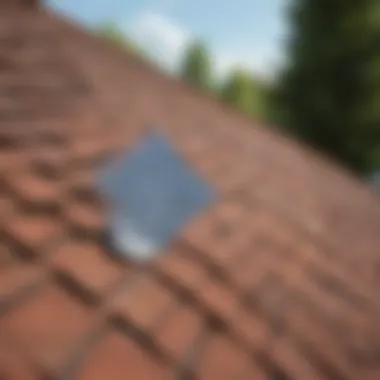Understanding Home Warranty Coverage for Roof Leaks


Intro
Homeownership comes with numerous responsibilities, one of which is maintaining the integrity of your roof. Roof leaks can lead to significant damage if not addressed promptly, making home warranty coverage an important consideration for many homeowners. This article seeks to clarify the aspects of home warranty plans related to roofing issues, detailing what is typically covered and how to navigate the claims process. Understanding the nuances of a home warranty can help homeowners make informed decisions and protect their investments more effectively.
Overview of Home Warranty Coverage
Home warranty coverage serves as a safeguard against unexpected repairs and replacements. Unlike homeowner's insurance, which covers damage resulting from unforeseen incidents like storms or theft, home warranties primarily focus on the failure of systems and appliances due to normal wear and tear.
Coverage Details
Most home warranty plans include various components:
- Roof leaks: Coverage typically addresses leaks stemming from design defects or material failure.
- Structural coverage: This may include coverage for supporting structures if they affect the roof.
- System components: Such as vents or flashing that may cause leaks.
It's critical to read the terms and conditions carefully to know what is included and excluded in the policy.
Claims Process for Roof Leaks
When faced with a roof leak, understanding the claims process under a home warranty is vital. Here’s a typical outline of the procedure:
- Document the Issue: Take photos and notes of the leak's location and extent.
- Notify Your Home Warranty Provider: Contact them to report the issue and file a claim.
- Review Terms: Ensure the leak is covered based on your policy.
- Schedule an Inspection: A qualified professional will assess the situation and determine eligibility for coverage.
- Approval and Repair: If covered, repairs will be authorized.
"Understanding the claims process allows homeowners to react effectively when faced with unexpected repairs."
Comparing Home Warranties with Homeowner's Insurance
Knowing how home warranties differ from homeowner's insurance can aid in making informed decisions.
Key Differences
- Coverage Type: Home warranties focus on systems and appliances; insurance covers major unforeseen events.
- Claims Trigger: Warranties may kick in when appliances have wear and tear, while insurance is for accidents and damages.
Understanding these distinctions ensures homeowners choose the right protection for their needs.
Resources and Tools
Various resources are available to assist homeowners in understanding coverage options better:
- Tools and Calculators: Online calculators can help estimate the potential cost of repairs versus warranty premiums.
- Further Reading: Websites such as Wikipedia and Britannica have extensive articles on home warranties and insurance policies for detailed insights.
Prelims to Home Warranties
Home warranties are often misunderstood yet play an important role in protecting homeowners from unexpected repair costs. This section aims to elucidate the significance of home warranties in the context of roof leaks, outlining their essential elements and benefits. Understanding home warranties sets the foundation for homeowners to make informed decisions regarding their property protection.
Definition of Home Warranty
A home warranty is a service contract that covers the repair or replacement of essential home systems and appliances due to normal wear and tear. Unlike homeowners insurance, which protects against damages from disasters or theft, home warranties specifically address the functional aspects of a property. They ensure that when key components, like electrical systems or major appliances fail, homeowners are not left with exorbitant repair bills.
Purpose of Home Warranties
The primary purpose of home warranties is to provide peace of mind. They serve as a financial safety net, shielding homeowners from unexpected costs associated with repairs. This is particularly relevant for roof leaks, where the damage can escalate rapidly if not addressed promptly. Home warranties also save time as they often come with a network of service providers who can handle repairs efficiently. Moreover, these contracts can increase the attractiveness of a home during resale, offering potential buyers added assurance regarding upkeep and maintenance.


Overview of Coverage Types
Home warranties vary widely in their terms and coverage options. Typically, there are two main types of coverage:
- Systems Coverage: This option usually includes major home systems like HVAC, plumbing, and electrical systems. It can cover issues arising from everyday use.
- Appliance Coverage: This includes kitchen and laundry appliances such as ovens, refrigerators, and washers.
Some plans may offer comprehensive coverage that includes both systems and appliances as well as specialized items like pools or spas. Homeowners should carefully review different plans to understand what is covered and any potential exclusions. This understanding is critical, especially in cases of roof leaks, where knowing the limits of coverage can inform maintenance strategies.
Understanding Roof Leaks
When it comes to safeguarding a home, understanding roof leaks is essential. Roof leaks can lead to significant damage, and knowing how to identify them can prevent costly repairs. Homeowners should be aware of the causes and signs of leaks to protect their property effectively.
Common Causes of Roof Leaks
Several factors contribute to roof leaks. Some of the most common causes include:
- Age of the Roof: Over time, roofs can degrade due to weather exposure. Aging shingles may become brittle and crack, allowing water to seep through.
- Poor Installation: If the roof was not installed correctly, such as improper flashing around chimneys or vents, leaks can develop.
- Weather Damage: Severe storms, high winds, and hail can damage roofing materials, leading to vulnerabilities that cause leaks.
- Clogged Gutters: When gutters are blocked, water can pool on the roof, increasing the risk of leaks.
- Flashing Issues: Flashing is a key component that seals roof joints. Damaged or improperly installed flashing can create openings for water to enter.
Recognizing these causes is crucial for any homeowner. Early detection of these issues can help mitigate damage and maintain a solid roof over your head.
Signs of a Roof Leak
Being able to identify signs of a roof leak is just as important as understanding the causes. Here are some common indicators:
- Water Stains on Ceilings or Walls: Noticeable water stains are often the first sign of a leak. These stains can indicate water pooling or flowing from the roof down.
- Peeling Paint or Wallpaper: Water intrusion can also cause paint or wallpaper to blister or peel. This aesthetic damage often means there's more going on beneath the surface.
- Mold Growth: Persistent moisture from a leak can lead to mold. If you notice unexplained mold in your home, check the roof.
- Visible Damage on the Roof: Look for missing shingles, cracked tiles, or sagging areas that may allow water entry.
- Water Puddles in Attic: If you notice water pooling in your attic, it is time to take immediate action.
"Identifying roof leaks early can save homeowners from costly repairs and extensive damage."
Understanding these signs can help homeowners make timely decisions regarding their roof’s integrity. Regular inspections, especially after severe weather, are a proactive step to catch problems early.
By comprehending the causes and signs of roof leaks, homeowners can better protect their property and make informed choices regarding home warranties.
The Intersection of Roof Leaks and Home Warranties
Understanding the relationship between roof leaks and home warranties is critical for homeowners. Roof leaks can cause significant damage to a property, leading to costly repairs. Home warranties are designed to provide coverage for such issues, but the specifics can vary among providers. Knowing how these two aspects interconnect can aid homeowners in making informed decisions regarding their coverage.
When we discuss home warranty coverage in relation to roof leaks, several elements come into play. Primarily, it is essential to understand what areas of a roof a typical home warranty covers. This can include leaks caused by general wear and tear, specific repairs, or necessary replacements. Home warranties often cover the costs of labor and materials associated with these repairs, alleviating some financial burdens.
However, not all roof issues are automatically covered. Homeowners must consider several factors to ensure they have adequate protection. For instance, a warranty might focus only on specific types of roofing materials or might exclude leaks resulting from negligence or lack of maintenance. This is why grasping the terms of a home warranty becomes indispensable.
Additionally, understanding how these policies operate helps clarify what steps a homeowner should take when faced with a roof leak. For example, knowing the claims process can streamline addressing any roof issues efficiently. )
What is Typically Covered
Home warranties typically cover a range of services related to roof leaks. Commonly covered repairs may include issues stemming from roofing materials, such as shingles. If these materials are defective or suffer from wear over time, most home warranties will cover the costs associated with their replacement or repairs.
Additional coverage elements may include:
- Flashing repair: If the metal or other materials surrounding vent pipes or chimneys need replacement, warranty coverage usually applies.
- Structural issues: Some plans may address leaks caused by structural concerns within the roofing system.
- Labor costs: Many warranties encompass both labor and parts, streamlining the repair process for the homeowner.
It's advisable for homeowners to read their warranty documents carefully. They should understand what is included under their specific plan, as stipulations can vary widely.
Exclusions Regarding Roof Issues


While home warranties can provide extensive coverage, they often come with significant exclusions that homeowners should be aware of.
Common exclusions may encompass issues not related to normal wear and tear or those resulting from negligence.
For instance, if a roof leak results from an existing problem that the homeowner should have addressed beforehand, the warranty might not cover repairs. Other common exclusions include:
- Weather-related damage: Damage caused by severe weather events, such as hurricanes or hailstorms, is typically not included.
- Improper installation: If the roof was poorly installed, homeowners might find themselves outside the warranty's coverage.
- Maintenance neglect: Leaks arising due to lack of regular maintenance and care are usually excluded, emphasizing the importance of regular roof checks and upkeep.
Thus, homeowners need to maintain proper documentation and undertake routine maintenance exercises to ensure protection against possible exclusions in their home warranty.
Differences between Home Warranties and Homeowners Insurance
Understanding the distinctions between home warranties and homeowners insurance is crucial for any homeowner. They serve different purposes and are designed to protect against various risks that can arise in the home environment. Recognizing these distinctions assists in making informed decisions about coverage.
Key Distinctions
Home warranties and homeowners insurance address unique needs, even though they both offer a form of protection for your home. Here are some key differences:
- Scope of Coverage: Home warranties primarily cover the repair or replacement of home systems and appliances that fail due to normal wear and tear. This includes items like the HVAC system, plumbing, and kitchen appliances. In contrast, homeowners insurance protects against damages to the property itself due to unforeseen events, such as fire, theft, or natural disasters.
- Claim Triggers: Warranties usually kick in when there is a mechanical failure, while insurance claims arise from specific perils like vandalism or severe weather. This means that homeowners must determine the cause of the issue before deciding on the claim process.
- Premium and Deductible Structure: Home warranty plans typically require a flat-fee premium along with a service fee per claim, which is often lower than a traditional insurance deductible. Homeowners insurance may have a higher annual premium and varied deductible based on the value of the coverage and the risks involved.
- Exclusions: Warranties may exclude certain items or issues, such as pre-existing conditions, while insurance policies often have specific exclusions, like flood or earthquake damage, unless additional coverage is bought.
When to Rely on Each
Knowing when to rely on a home warranty versus homeowners insurance can save homeowners time and money.
- Home Warranties are ideal for:
- Homeowners Insurance is suited for:
- Routine maintenance issues and breakdowns of major systems and appliances.
- Homeowners with older systems that are more prone to failure due to age.
- Situations where the cost of repair or replacement exceeds the service fee.
- Damage resulting from unforeseen incidents such as fires, storms, or theft.
- Liability coverage if someone is injured on the property.
- Protection against the loss of personal property due to specified perils.
By clearly understanding these differences, homeowners can navigate their coverage options more effectively and ensure that their investments are well protected.
Remember: Each situation is unique, and it may be prudent to consult with a professional to assess your specific needs and coverage gaps.
Navigating Home Warranty Claims for Roof Leaks
Navigating home warranty claims for roof leaks is an essential topic for homeowners. Understanding this process can save time and money. Roof leaks can cause significant damage to a home if not addressed promptly. Home warranty plans often cover some roof repairs, but the claims process can be complex. Knowing the steps involved can help homeowners get their necessary repairs done quickly and efficiently.
The Claims Process Explained
The claims process for roof leaks typically begins with discovering the issue. Homeowners must promptly report any leaks to their home warranty provider. The first step is to make a formal claim. It usually involves contacting the warranty company’s customer service. It is best to provide a clear description of the problem. The representative will guide homeowners through the subsequent steps.
Once the claim is submitted, the warranty company may send a technician to assess the damage. This visit is critical. The technician will determine if the issue is covered under the warranty. If covered, repairs can begin without upfront costs to the homeowner. Keep in mind that there can be service fees. These fees vary based on the warranty provider, so it's wise to check your contract.
Documentation Requirements
Proper documentation is vital for a successful claim. Homeowners should keep records of any communication with their warranty company. This includes dates, times, and names of representatives spoken to. Additionally, photographs of the damage can be beneficial. They serve as proof and provide clarity to the situation.
Some of the typical documentation requirements include:
- Claim Form: Complete any forms necessary to initiate a claim.
- Evidence of Damage: Take clear photos of the leak and affected area.
- Maintenance Records: Document any maintenance done on the roof in the past. This proves that the homeowner properly cared for their property.
- Important Documents: Provide a copy of the home warranty contract.


"Good documentation can make or break a claim. It is better to have too much information than not enough."
Successfully navigating the claims process requires attention to detail and proactive communication. Keeping organized notes and clear documentation can enhance the likelihood of a smooth claims experience.
Factors Influencing Coverage and Claims
In the realm of home warranty coverage, several factors shape how claims are processed and what is covered. Understanding these elements allows homeowners to make informed decisions. Knowing what influences coverage can significantly affect the outcome of leaky roof claims. Often, aspects like policy specifics and maintenance history dictate the efficiency of claims. A robust grasp of these influences is paramount for homeowners looking to protect their investments while minimizing potential losses.
Policy Variability Among Providers
Home warranty plans can differ markedly between providers. Some companies offer extensive coverage that addresses roof leaks, while others may impose restrictions or exclude certain types of damages. For example, one provider might cover the structural components of a roof, while another only addresses installation defects. This variation often leads to confusion during claims.
When selecting a provider, it's critical to read the fine print. Ensure that you understand the terms, including what weather conditions or incidents might be considered legitimate causes for a claim. Here are a few points to consider when evaluating policy variability:
- Covered Perils: Verify which specific scenarios for roof leaks are covered.
- Claim Limits: Investigate if there are caps on what can be claimed for roof repairs.
- Service Fees: Understand if the provider requires a service fee upon filing a claim.
Choosing the right provider can make a substantial difference in managing home warranty claims effectively.
Impact of Maintenance Records
Another significant factor influencing claims is the maintenance history of the roof. Home warranty companies often look at maintenance records as a criterion for determining claims validity. Regular roof inspections and timely repairs improve the likelihood of a successful claim. Here are vital points to consider:
- Documentation: Keep detailed records of any maintenance or repairs made to your roof. This can include receipts from contractors or inspection reports.
- Frequency of Maintenance: The more often a homeowner conducts maintenance, the more positive the perception will be when filing a claim.
- Condition Reports: If an issue arises, having documented evidence of recent assessments can bolster your case with the warranty provider.
Best Practices for Homeowners
Understanding and managing home warranty coverage, particularly regarding roof leaks, is crucial for homeowners. This section provides valuable insights into the best practices that can help homeowners navigate their warranty options effectively. By being proactive and informed, homeowners can enhance their chances of accessing the coverage they need when incidents arise.
Assessing Your Warranty Needs
First, it's important to assess your warranty needs. Every home is unique, and factors such as age, location, and local weather conditions can influence the necessity of a home warranty. Evaluate your roof's condition and its maintenance history. If your roof is older or has had previous issues, a warranty may offer financial protection and peace of mind.
Additionally, consider the specific terms of different home warranty providers. Look for coverage that extends to roof leaks and inspect any limitations or exclusions that might apply. Reading through customer reviews and experiences will also provide insights into a provider's reliability and service quality.
Regularly reassessing your warranty needs is also advisable as your circumstances change, such as when you renovate your home or move to a new location. Keeping your warranty aligned with your unique situation can save you stress and potential costs in the future.
Regular Roof Maintenance Tips
Regular maintenance is essential for preventing roof leaks and prolonging the lifespan of your roof. Here are some key tips for maintaining your roof:
- Schedule Professional Inspections: At least once a year, hire a qualified roofing contractor to inspect your roof for any signs of wear or potential leaks. Their expertise can catch issues before they escalate.
- Clear Debris: Regularly remove leaves, branches, and other debris from your roof and gutters. Blockages can cause water to pool and lead to leaks.
- Check Flashing and Seals: Ensure that the flashing around chimneys, vents, and skylights is secure and intact. Any gaps can let water in.
- Trim Overhanging Branches: Trees close to your roof can drop branches that may damage the roof surface or contribute to debris buildup.
- Ensure Proper Ventilation: Good ventilation in your attic helps prevent moisture buildup. This can reduce your risk of leaks and improve energy efficiency.
Maintaining your roof regularly can help mitigate the need to rely on your home warranty, giving you a stronger stance when claiming.
Finale and Final Thoughts
In this article, we have highlighted several key elements essential to grasping home warranty dynamics. Each section has provided insights into the definitions, coverage types, claims processes, and distinctions between warranties and insurance.
Summary of Key Points
- Definition and Purpose: Home warranties serve as a safety net for unexpected repair costs, focusing on home systems and appliances, including roofing.
- Common Causes and Signs of Roof Leaks: Identifying causes such as weather conditions or improper installation helps in recognizing signs early, preventing major issues.
- Coverage Insights: Not all warranties cover roof issues comprehensively, and understanding what is included or excluded is vital.
- Claims Process: Knowing how to navigate the claims process can simplify addressing issues and securing compensation when necessary.
- Differences from Insurance: Home warranties and homeowners insurance serve different purposes. Understanding when to use each can save time and money.
- Maintenance Best Practices: Regular checks and maintenance can mitigate problems, prioritizing preventative care that may impact warranty claims.
Making Informed Decisions
As a homeowner, making informed decisions about home warranty coverage involves more than just selecting a plan; it is about understanding what you are signing up for.
- Assess Warranty Options: Review multiple providers, comparing coverage specifics and interpretations of roof-related claims.
- Read Policy Details: Pay close attention to exclusions and limits within your policy to avoid unexpected surprises.
- Plan for Maintenance: Create a maintenance schedule that incorporates professional inspections and necessary repairs. This strategy might positively affect future claims under your warranty.
In remembering these points, you can navigate the complexities of home warranties confidently and wisely. Adequate preparation and knowledge empower homeowners. The path from understanding to action can ultimately safeguard your investment in your home.







